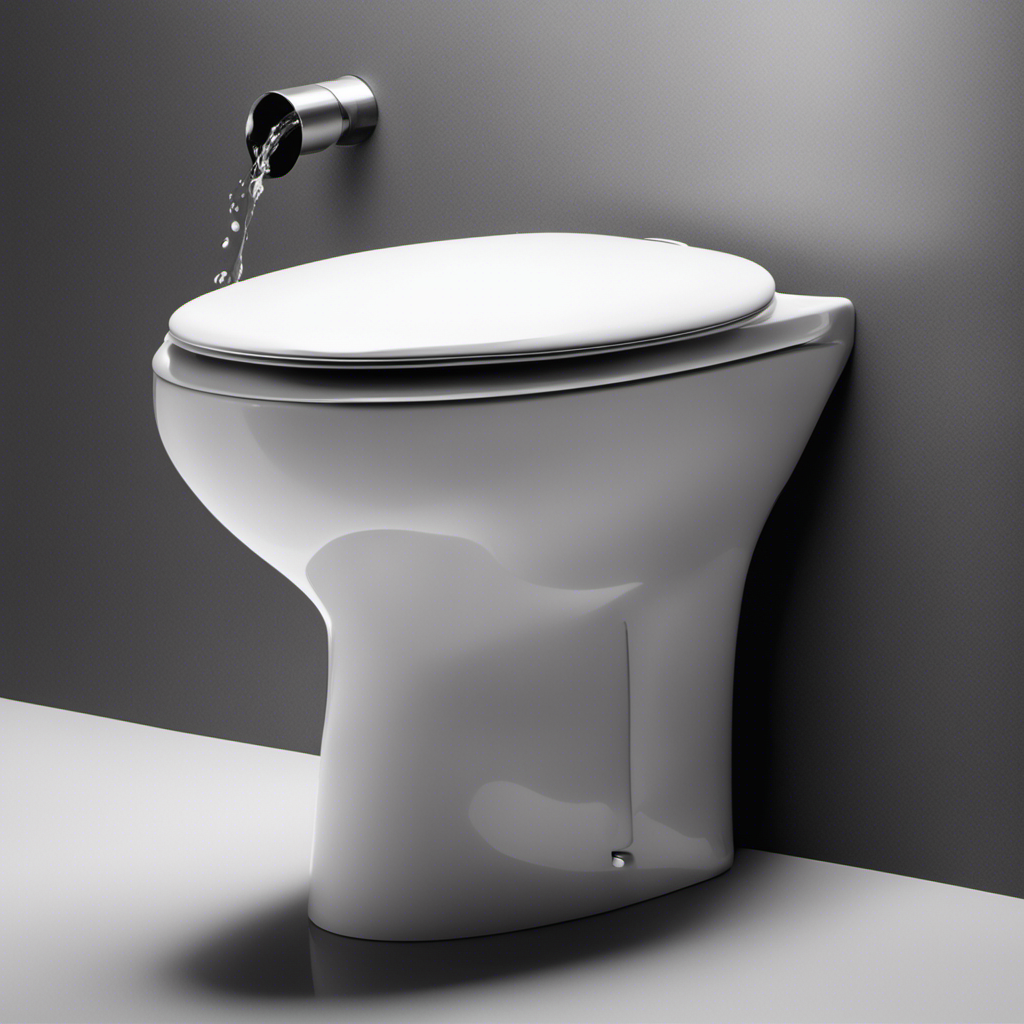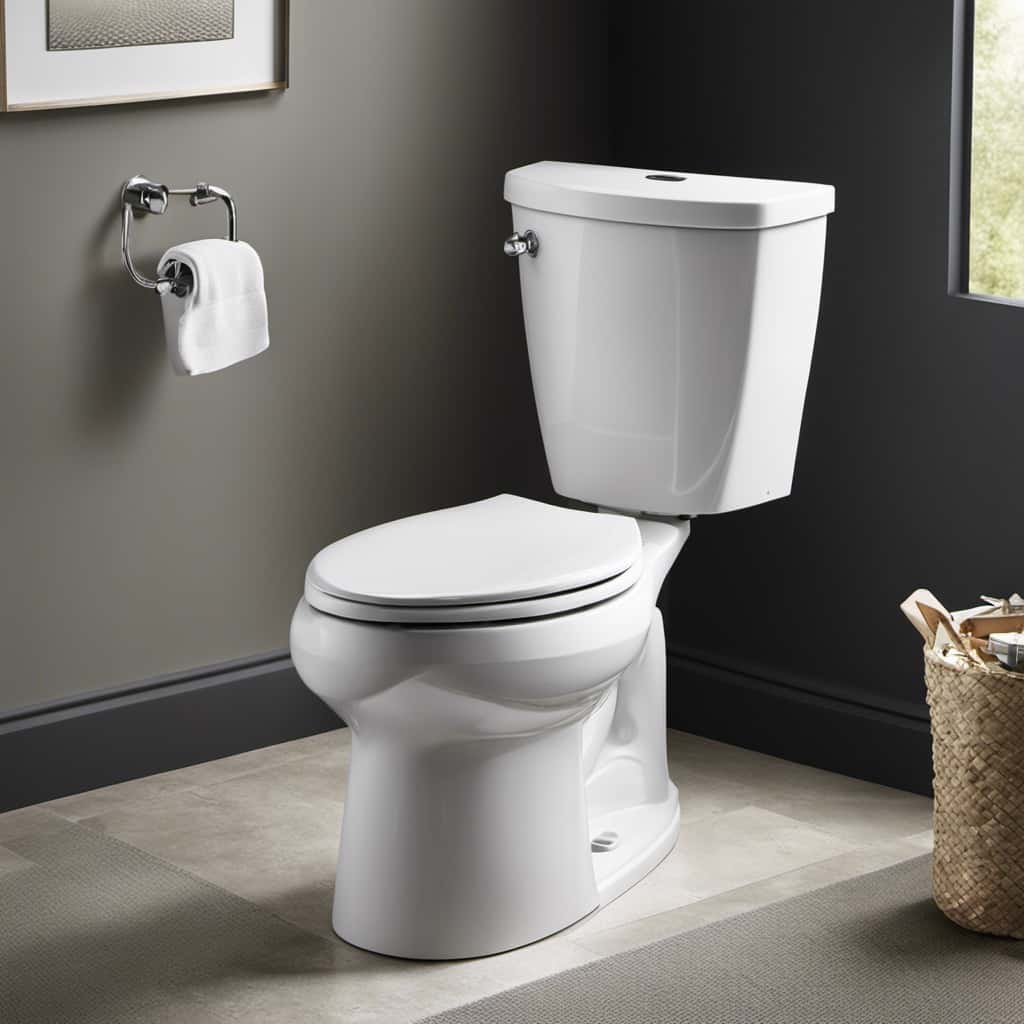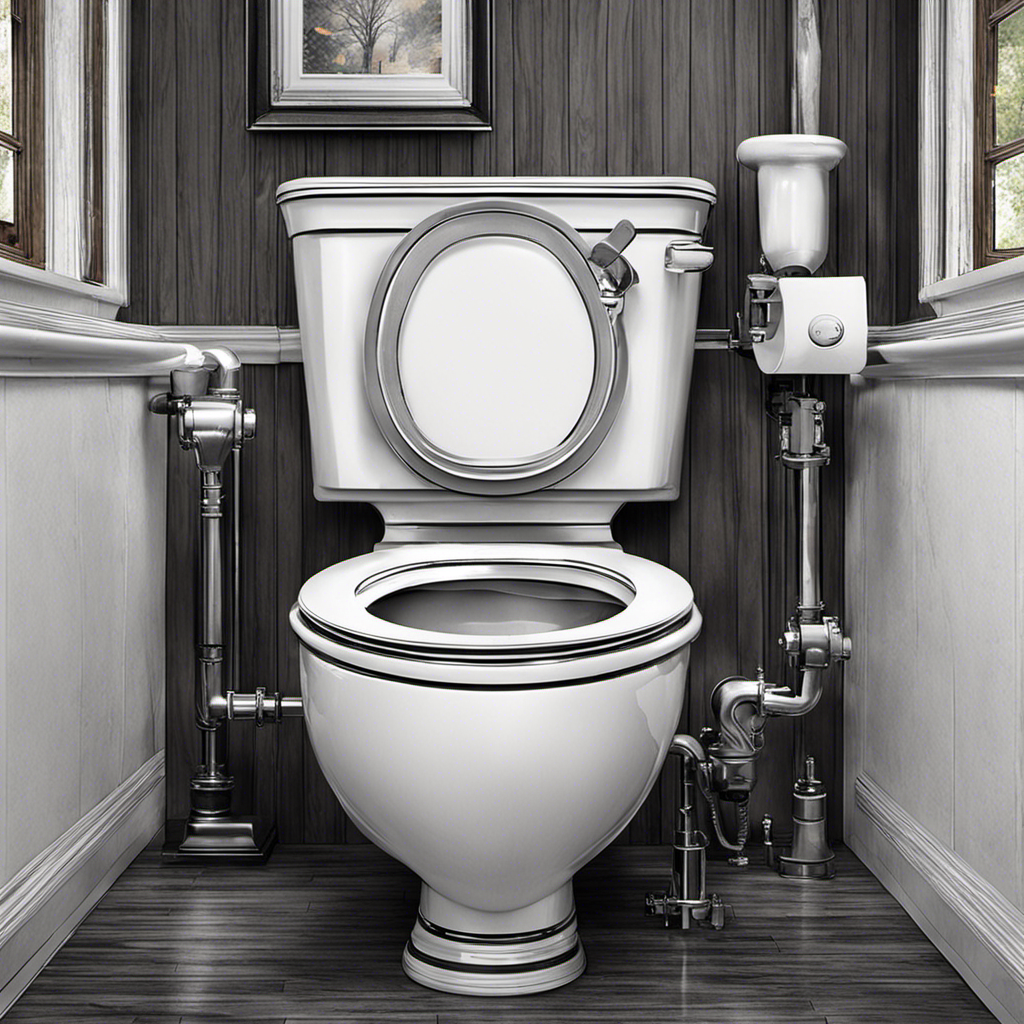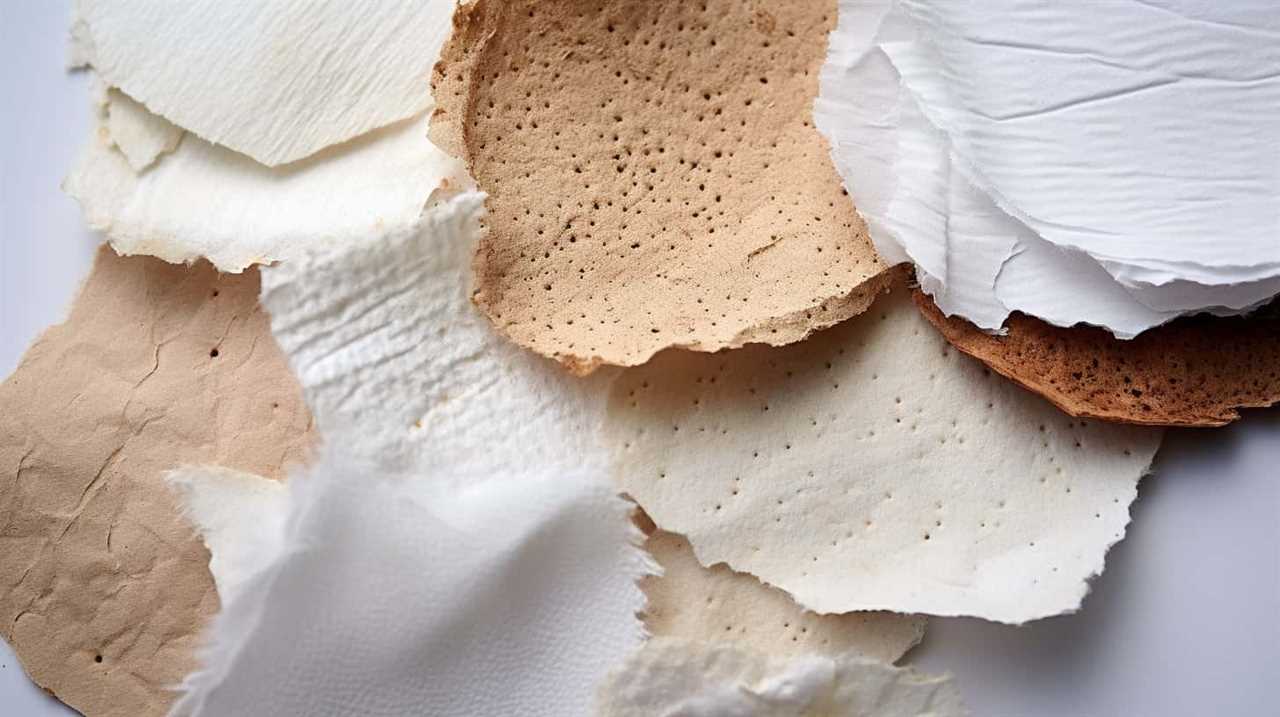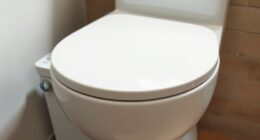Is your toilet hissing like a snake? Don’t panic, because there’s a simple solution to fix this annoying problem.
In this article, we’re going to show you exactly how to tackle that hissing toilet and bring peace back to your bathroom.
By following these easy steps, you’ll be able to:
- Identify the source of the hissing
- Check the fill valve
- Adjust the water level
- Fix a leaky flapper
- Clean the flush valve
- Know when it’s time to call in the professionals.
Let’s get started!
Key Takeaways
- Hissing sound in toilets is commonly caused by a faulty fill valve or a leaky flapper.
- The source of the hissing can be identified by checking the water supply valve and observing if the hissing stops when the water supply is shut off.
- Adjusting the fill valve and water level can help fix the hissing sound.
- Maintaining and fixing a hissing toilet is important to conserve water resources, prevent water wastage, and avoid more severe toilet problems.
Understanding the Hissing Sound
You might be wondering why your toilet is making a hissing sound. Don’t worry, it’s a common issue that can easily be fixed.
The first step is to understand the cause of the hissing sound. One common cause is a faulty fill valve. This valve controls the water flow into the toilet tank. If it’s not working properly, it can cause the hissing sound.
Another possible cause is a leaky flapper. The flapper is responsible for sealing the water in the tank. If it’s worn out or damaged, it can cause water to leak and create a hissing sound.
To troubleshoot these issues, you can try adjusting the fill valve or replacing the flapper. These simple steps should help you fix your hissing toilet.
Identifying the Source of the Hissing
To identify the source of the hissing, it’s important to first check the water supply valve. This valve is usually located behind the toilet, near the floor. Turn the valve clockwise to shut off the water supply to the toilet.
Wait for a few minutes and observe if the hissing sound stops. If it does, it means that the hissing noise was caused by a faulty fill valve. In this case, you can try cleaning or replacing the fill valve to resolve the issue.
However, if the hissing sound continues even after shutting off the water supply, the problem might be with the flush valve or the flapper. These components may need troubleshooting solutions or possible repairs.
Checking the Fill Valve
The first step in checking the fill valve is to locate it behind the toilet near the floor. The fill valve is responsible for regulating the water level in your toilet tank.
If you suspect that the fill valve is the source of the hissing sound, there are a couple of things you can do. First, check for any visible signs of damage or wear on the fill valve. If you notice any, it may be necessary to replace the fill valve altogether.
If the fill valve looks to be in good condition, you can try adjusting the float. The float is a small device connected to the fill valve that controls the water level. By adjusting the float, you can ensure that the water level is not too high, which could be causing the hissing sound.
Now, let’s move on to the next step: adjusting the water level.
Adjusting the Water Level
To prevent the hissing sound in your toilet and ensure optimal water level, there are a few key points to consider.
First, you need to adjust the water level to the appropriate height. This can be done by either lowering or raising the float arm or adjusting the fill valve.
Second, make sure that the fill valve is functioning properly and not causing any leaks or blockages.
Lastly, check for any potential issues with the flapper valve or the flush valve seal, as these can also contribute to the hissing sound.
Optimal Water Level
Make sure you’ve adjusted the water level in your toilet to the optimal setting. Maintaining the correct water level is essential for proper toilet function and can help prevent common issues like hissing noises.
Here’s how to ensure your water level is just right:
-
Locate the water level adjustment screw: This screw is usually found near the fill valve or float ball.
-
Turn the screw clockwise to lower the water level: If the water level is too high, turning the screw will lower it.
-
Turn the screw counterclockwise to raise the water level: If the water level is too low, turning the screw will raise it.
-
Test the water level: After making adjustments, flush the toilet and observe the water level. It should be approximately one inch below the overflow tube.
Preventing Hissing Sound
Ensure you adjust the water level correctly to prevent any unwanted hissing sounds. When the water level in your toilet tank is too high, it can result in excessive water pressure, leading to a hissing sound. This not only causes annoying noises but also contributes to water wastage. To troubleshoot this issue, follow the steps below:
- Turn off the water supply valve located behind the toilet.
- Remove the toilet tank lid and locate the water level adjustment screw or float cup.
- Adjust the screw or float cup to lower the water level to the recommended mark indicated on the inside of the tank.
- Turn the water supply valve back on and check for any hissing sounds.
Fixing a Leaky Flapper
If you’re experiencing a leaky flapper in your toilet tank, don’t worry – it’s a common problem that can be easily fixed.
In this discussion, we’ll walk you through the steps to replace your flapper, which is the most common solution to this issue.
We’ll also cover the common problems you may encounter with your flapper and the tools you’ll need for the repair.
Flapper Replacement Steps
To fix a hissing toilet, start by checking the flapper for any signs of damage or wear. If you notice any issues, it’s time to replace the flapper. Here are the steps to successfully replace the flapper:
- Turn off the water supply to the toilet by closing the shut-off valve located behind the toilet.
- Flush the toilet to drain the tank completely.
- Remove the old flapper by detaching the chain from the flush handle and unhooking it from the overflow pipe.
- Install the new flapper by attaching the chain to the flush handle and hooking it onto the overflow pipe.
By following these steps, you can easily replace the flapper and fix the hissing sound in your toilet.
Regular flapper maintenance is essential to prevent leaks and ensure the proper functioning of your toilet.
Common Flapper Problems
When dealing with common flapper problems, you may notice issues such as the flapper not sealing properly or the chain being too loose. These problems can often lead to a hissing sound coming from your toilet. Troubleshooting flapper issues is essential to fix a hissing toilet.
Firstly, check if the flapper is properly seated on the flush valve. If it’s not, adjust it so that it creates a tight seal.
Next, ensure that the chain connecting the flapper to the flush handle is not too loose. Adjust the length of the chain if needed, ensuring that there is some slack but not too much.
By troubleshooting these flapper problems, you can resolve the hissing issue and restore the proper functioning of your toilet.
Now, let’s move on to the tools needed for repair.
Tools Needed for Repair
The tools you’ll need for repair include a wrench, a screwdriver, and a pair of pliers. Here are four essential repair techniques and troubleshooting tips to fix a hissing toilet:
-
Check the water level: Ensure that the water level in the tank is set at the correct height. Adjust the float valve if necessary.
-
Inspect the flapper: Examine the flapper for any signs of wear or damage. If it’s worn out, replace it with a new one.
-
Tighten connections: Check all the connections, such as the fill valve and supply line, and make sure they are tight. Loose connections can cause hissing.
-
Clean the fill valve: Sediment buildup can cause the fill valve to malfunction. Clean it thoroughly to remove any debris and restore proper function.
By following these repair techniques and troubleshooting tips, you can fix a hissing toilet and prevent water wastage.
Now, let’s move on to cleaning the flush valve.
Cleaning the Flush Valve
First, check if the flush valve is clean and free of debris. Remove the tank lid and locate the flush valve at the bottom of the tank. Inspect it for dirt, mineral buildup, or obstructions. If you see any blockage, use a small brush or toothbrush to scrub the valve and remove the debris.
Another cleaning technique is to pour a mixture of vinegar and water into the tank. Let it sit for a few hours to dissolve stubborn deposits.
If cleaning the flush valve doesn’t solve the hissing issue, it’s best to seek professional help to diagnose and fix the problem.
Seeking Professional Help
If cleaning the flush valve doesn’t work, it’s time to call a professional for help. While DIY troubleshooting can often solve common toilet issues, some problems may require the expertise of a trained plumber.
Here are a few reasons why seeking professional help is the best option:
-
Expertise: Plumbers have the knowledge and experience to accurately diagnose and fix complex toilet problems.
-
Time-saving: Hiring a professional can save you valuable time, as they can quickly identify the issue and provide a solution.
-
Safety: Certain toilet issues, such as major leaks or sewer line problems, can be hazardous to handle without the proper equipment and training.
-
Long-term solutions: Professionals can provide lasting repairs, ensuring that the problem doesn’t recur in the future.
When all DIY options have been exhausted, don’t hesitate to reach out to a professional for assistance. They can provide the expertise and solutions needed to fix your hissing toilet effectively.
Conclusion
So there you have it, folks! Now that you know how to fix a hissing toilet, you can say goodbye to that annoying sound once and for all.
Remember, it’s important to understand the source of the hissing, whether it’s a faulty fill valve, a water level issue, or a leaky flapper.
By following the steps outlined in this article, you’ll be able to address the problem and get your toilet back in working order.
And if all else fails, don’t hesitate to seek professional help. After all, sometimes it’s best to leave it to the experts.
Happy fixing!
